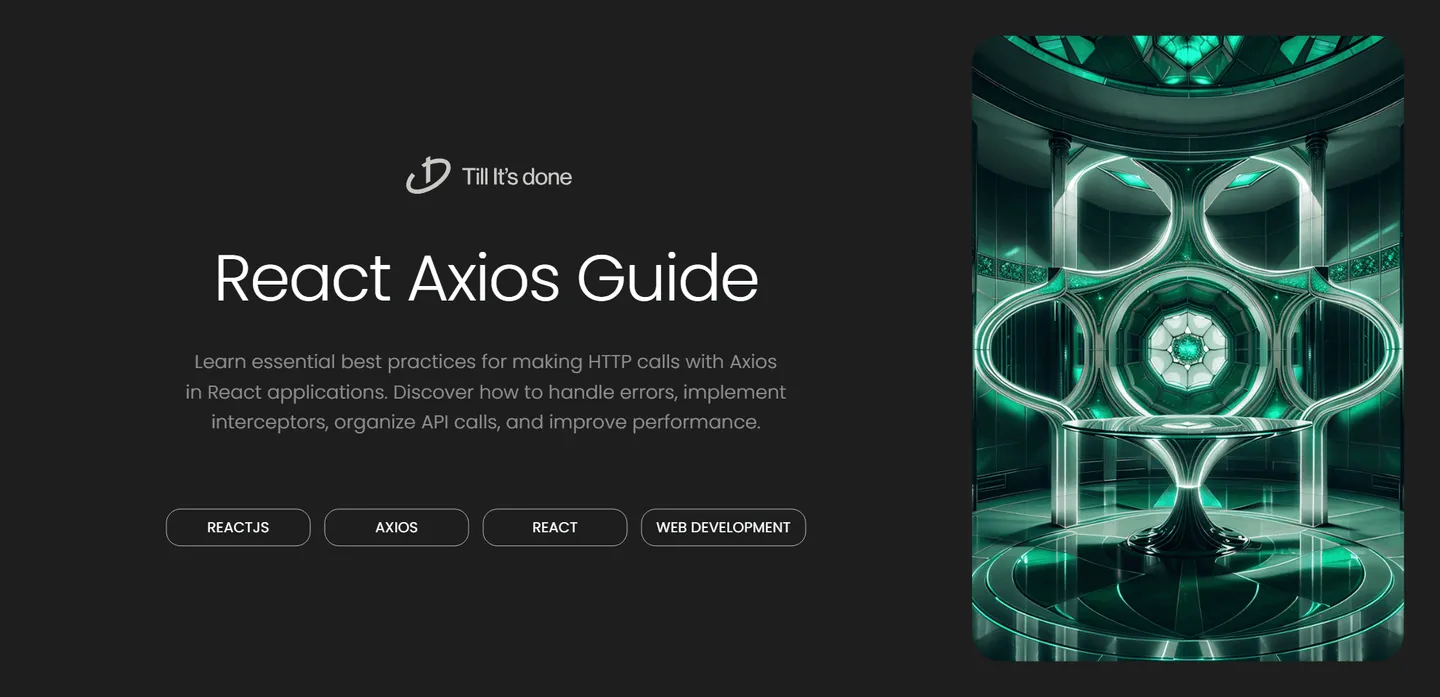- Services
- Case Studies
- Technologies
- NextJs development
- Flutter development
- NodeJs development
- ReactJs development
- About
- Contact
- Tools
- Blogs
- FAQ
Best Practices for Axios HTTP Calls in React
Discover how to handle errors, implement interceptors, organize API calls, and improve performance.

Best Practices for Making HTTP Calls with Axios in React

Making HTTP calls is a fundamental part of modern web applications, and when it comes to React development, Axios stands out as one of the most popular choices for handling these requests. Let’s dive into some best practices that will help you write cleaner, more maintainable, and more efficient code when working with Axios in your React applications.
Setting Up Axios Instance
One of the most crucial best practices is creating a centralized Axios instance. This approach helps maintain consistency across your application and makes it easier to manage common configurations.
Instead of importing Axios directly in each component, create a separate configuration file:
import axios from 'axios';
const axiosInstance = axios.create({ baseURL: process.env.REACT_APP_API_URL, timeout: 5000, headers: { 'Content-Type': 'application/json' }});
export default axiosInstance;
Error Handling and Interceptors
Implementing proper error handling is essential for a robust application. Axios interceptors provide a clean way to handle errors globally:
axiosInstance.interceptors.response.use( response => response, error => { if (error.response.status === 401) { // Handle unauthorized access localStorage.removeItem('token'); window.location = '/login'; } return Promise.reject(error); });Organizing API Calls
Create dedicated service files for different features or entities in your application. This separation of concerns makes your code more maintainable and reusable:
import api from '../api/axios.config';
export const userService = { getUser: (id) => api.get(`/users/${id}`), updateUser: (id, data) => api.put(`/users/${id}`, data), deleteUser: (id) => api.delete(`/users/${id}`)};
Using Async/Await with Hooks
When making API calls in React components, combine Axios with React hooks for clean and efficient data fetching:
const UserProfile = ({ userId }) => { const [user, setUser] = useState(null); const [loading, setLoading] = useState(false); const [error, setError] = useState(null);
useEffect(() => { const fetchUser = async () => { try { setLoading(true); const { data } = await userService.getUser(userId); setUser(data); } catch (err) { setError(err.message); } finally { setLoading(false); } };
fetchUser(); }, [userId]);
// Component render logic};Request Cancellation
Remember to cancel ongoing requests when a component unmounts to prevent memory leaks and unwanted state updates:
useEffect(() => { const abortController = new AbortController();
const fetchData = async () => { try { const { data } = await axiosInstance.get('/endpoint', { signal: abortController.signal }); // Handle data } catch (error) { if (error.name === 'AbortError') { // Handle abort } } };
fetchData();
return () => abortController.abort();}, []);Cache and Request Deduplication
Implement request caching and deduplication to improve performance and reduce unnecessary network calls:
const cache = new Map();
const fetchWithCache = async (url) => { if (cache.has(url)) { return cache.get(url); }
const response = await axiosInstance.get(url); cache.set(url, response.data); return response.data;};Remember to clear the cache when needed and implement cache invalidation strategies based on your application’s requirements.

 สร้างเว็บไซต์ 1 เว็บ ต้องใช้งบเท่าไหร่? เจาะลึกทุกองค์ประกอบ website development cost อยากสร้างเว็บไซต์แต่ไม่มั่นใจในเรื่องของงบประมาณ อ่านสรุปเจาะลึกตั้งแต่ดีไซน์, ฟังก์ชัน และการดูแล พร้อมตัวอย่างงบจริงจาก Till it’s done ที่แผนชัด งบไม่บานปลายแน่นอน
สร้างเว็บไซต์ 1 เว็บ ต้องใช้งบเท่าไหร่? เจาะลึกทุกองค์ประกอบ website development cost อยากสร้างเว็บไซต์แต่ไม่มั่นใจในเรื่องของงบประมาณ อ่านสรุปเจาะลึกตั้งแต่ดีไซน์, ฟังก์ชัน และการดูแล พร้อมตัวอย่างงบจริงจาก Till it’s done ที่แผนชัด งบไม่บานปลายแน่นอน  Next.js สอน 14 ขั้นตอนเบื้องต้น: สร้างโปรเจกต์แรกใน 30 นาที เริ่มต้นกับ Next.js ใน 14 ขั้นตอนเพียงแค่ 30 นาที พร้อม SSR/SSG และ API Routes ด้วยตัวอย่างโค้ดง่าย ๆ อ่านต่อเพื่อสร้างโปรเจ็กต์แรกได้ทันทีที่นี่
Next.js สอน 14 ขั้นตอนเบื้องต้น: สร้างโปรเจกต์แรกใน 30 นาที เริ่มต้นกับ Next.js ใน 14 ขั้นตอนเพียงแค่ 30 นาที พร้อม SSR/SSG และ API Routes ด้วยตัวอย่างโค้ดง่าย ๆ อ่านต่อเพื่อสร้างโปรเจ็กต์แรกได้ทันทีที่นี่  วิธีสมัคร Apple Developer Account เพื่อนำแอปขึ้น App Store ทีละขั้นตอน อยากปล่อยแอปบน App Store ระดับโลก มาอ่านคู่มือสมัคร Apple Developer Account พร้อมเคล็ดลับ TestFlight และวิธีอัปโหลดที่ง่ายในบทความเดียวนี้ได้เลย
วิธีสมัคร Apple Developer Account เพื่อนำแอปขึ้น App Store ทีละขั้นตอน อยากปล่อยแอปบน App Store ระดับโลก มาอ่านคู่มือสมัคร Apple Developer Account พร้อมเคล็ดลับ TestFlight และวิธีอัปโหลดที่ง่ายในบทความเดียวนี้ได้เลย  TypeScript Interface คืออะไร? อธิบายพร้อมวิธีใช้และข้อแตกต่างจาก Type เรียนรู้วิธีใช้ TypeScript Interface เพื่อสร้างโครงสร้างข้อมูลที่ปลอดภัยและเข้าใจง่าย พร้อมเปรียบเทียบข้อดีข้อแตกต่างกับ Type ที่คุณต้องรู้ ถูกรวมเอาไว้ในบทความนี้แล้ว
TypeScript Interface คืออะไร? อธิบายพร้อมวิธีใช้และข้อแตกต่างจาก Type เรียนรู้วิธีใช้ TypeScript Interface เพื่อสร้างโครงสร้างข้อมูลที่ปลอดภัยและเข้าใจง่าย พร้อมเปรียบเทียบข้อดีข้อแตกต่างกับ Type ที่คุณต้องรู้ ถูกรวมเอาไว้ในบทความนี้แล้ว  Material-UI (MUI) คืออะไร อยากสร้าง UI สวยงามและเป็นมืออาชีพในเวลาอันรวดเร็วใช่ไหม มาทำความรู้จักกับ Material-UI (MUI) ที่ช่วยให้คุณพัฒนาแอปพลิเคชันบน React ได้ง่ายและดูดีในทุกอุปกรณ์
Material-UI (MUI) คืออะไร อยากสร้าง UI สวยงามและเป็นมืออาชีพในเวลาอันรวดเร็วใช่ไหม มาทำความรู้จักกับ Material-UI (MUI) ที่ช่วยให้คุณพัฒนาแอปพลิเคชันบน React ได้ง่ายและดูดีในทุกอุปกรณ์  เปรียบเทียบ 3 วิธีติดตั้ง install node js บน Ubuntu: NVM vs NodeSource vs Official Repo แบบไหนดีที่สุด? เรียนรู้วิธีติดตั้ง Node.js บน Ubuntu ด้วย NVM, NodeSource หรือ Official Repo เลือกวิธีที่เหมาะกับความต้องการของคุณ พร้อมเปรียบเทียบ เพื่อการพัฒนาที่มีประสิทธิภาพ!
เปรียบเทียบ 3 วิธีติดตั้ง install node js บน Ubuntu: NVM vs NodeSource vs Official Repo แบบไหนดีที่สุด? เรียนรู้วิธีติดตั้ง Node.js บน Ubuntu ด้วย NVM, NodeSource หรือ Official Repo เลือกวิธีที่เหมาะกับความต้องการของคุณ พร้อมเปรียบเทียบ เพื่อการพัฒนาที่มีประสิทธิภาพ! Talk with CEO
We'll be right here with you every step of the way.
We'll be here, prepared to commence this promising collaboration.
Whether you're curious about features, warranties, or shopping policies, we provide comprehensive answers to assist you.


